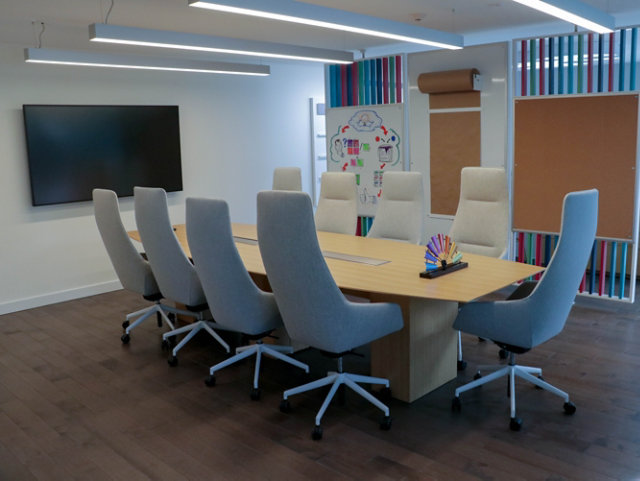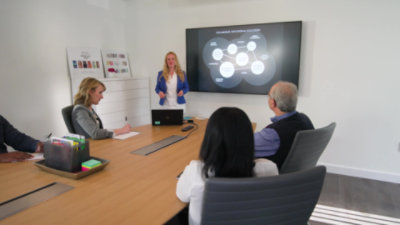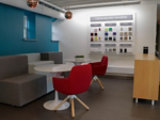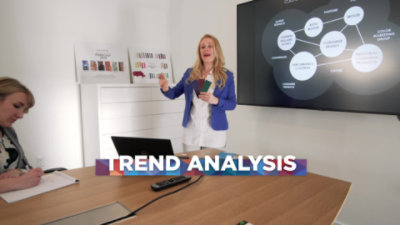Designhouse-Why-2021BolzVersion.mp4
[playful music plays throughout]
[gfx: image of liquid color making Sherwin-Williams logo]
[gfx: Sherwin-Williams DesignHouse]
[images of clouds rolling on trees, beekeeper, flower blooming, playing guitar, sandy beach, outdoor table and chairs, people sitting on roof of car, painting a part]
[gfx: Jason Bolz, Vice President, Global Sales and Marketing, Sherwin-Williams General Industrial]
Jason Bolz [00:00:07] Color is an incredibly tangible and emotional thing.
Amanda Pevito [00:00:11] Everything that the human eye sees, the emotions are all about the color.
[images of people looking at design board, DesignHouse interior]
Jason Bolz [00:00:16] The key, and just about everything you do in business today is speed to market. When you engage with color, you need to do so quickly, and you need to get it out into the marketplace quickly. DesignHouse was really created because we were listening to our customers. They had the inspiration piece dialed in and we brought the designers into the equation. We're able to bring innovation and speed to market together.
[gfx: Kiki Redhead, Global CMF & Trend Manager, Sherwin-Williams DesignHouse]
[images of people collaborating, paint cups mixing paint, Knick knacks on a shelf]
Kiki Redhead [00:00:37] One of the biggest visions that we had was, really, to develop a collaborative center where everyone can be in the same place at the same time. Our customers can now come in and collaborate with us here on site and ask us what if. What if we could create this sparkly finish? What if we could create this texture?
Jason Bolz [00:00:56] So when our customers come up with inspiring ideas, they don't have to wait to figure out what they look like.
[gfx: Amanda Pevito, Chemist & Technical Liaison, Sherwin-Williams DesignHouse]
[images of painting on a line, collaborating in DesignHouse]
Amanda Pevito [00:01:01] The designer has the idea they can work with a CMF trend person. Then Technical can step in and say, OK, this is what you want, this is what we can do, and I can go to manufacturing and out the door.
[images of paint samples, objects on a shelf, appliances and people]
Jason Bolz [00:01:12] It's a service that's unmatched in the industry. Industrial customers use multiple technologies when they paint their products. Bringing those technologies together all on one machine can be a difficult task. Our job in the DesignHouse is to make sure we do that in a way that's seamless to them, and to their customers.
Kiki Redhead [00:01:30] On an appliance, you'll have powder over metal on the front, liquid over the plastic control panel. You'll have coil on the side.
Amanda Pevito [00:01:39] You don't want the average consumer to know that. They don't care. All they care about is that the top, and the bottom, and the sides, and they all match.
Kiki Redhead [00:01:46] We can look at the colors together, at the same angle, and underneath the same light, so we can also account for any metamerism that might happen over the different technologies and across the different substrates.
[images of appliances and cars on assembly line, people speaking in DesignHouse]
Amanda Pevito [00:01:57] So it doesn't take six months to get a color approved. It takes us three months. And that extra three months they have on their competitor getting a new color to market
Kiki Redhead [00:02:06] Speed to market, time and cost are all benefits of working with the DesignHouse.
[images of cranes, painting sheet metal, people collaborating]
Jason Bolz [00:02:11] We found ourselves, in more than one occasion, in a position where we had to help our customers take cost out of their operation. And we can do that with color. Say, for example, a customer has a particular blue color, and they want to figure out how to reduce the cost, but not reduce the performance. We can use the science of color with pigment selection, and many other things, to drive exactly what the customer needs. We've had customers from a wide range of segments, from heavy equipment, appliances, to transportation, to building products, and we've brought them here and shown them success.
[image of meeting room collaboration]
Kiki Redhead [00:02:43] That's the real reward, getting to come up with new ways to share color with the world.
[images of man working at table, people collaborating, objects on shelf, futuristic car on road]
[gfx: computer and books for DesignHouse, A Spark Familiarity]
[image of robot walking to futuristic car]
[gfx: Inspired by the Future]
[image of native using instrument]
[gfx: Inspired by Culture]
[images of cactus, star cluster, pottery, jellyfish, people in meeting room, color palates]
[gfx: Inspired by the Environment]
Jason Bolz [00:02:49] Through the DesignHouse, our customers get access to, not only what they need today, but also an idea of what color looks like in the future and how we can drive that for them tomorrow.
Kiki Redhead [00:02:58] This is a really big initiative and it's a new approach that a lot of other coatings companies don't take. We can provide this sort of direction and information three, five years in advance,
[images of people collaborating, wall of colored bottles, reading color book, painting, kitchen, auto body shop, boat, cans on a shelf, exterior of DesignHouse]
Jason Bolz [00:03:12] Probably one of the most exciting things we're doing in the industrial business right now. When you think about Sherwin-Williams, most of the time, the first thing you think about is our consumer business, house paint. But there's so many other industries that we're involved in. Our business is so tied into color across so many different industries that we have a great idea where color was, where it is today, and where it's going. And that's a very powerful thing. And that's what's exciting about the DesignHouse. Our ability to bring that last piece of the puzzle together in a way that nobody else in the industrial coating space can do.
[gfx: image of liquid color making Sherwin-Williams logo]
[gfx: Sherwin-Williams DesignHouse]
[music fades out]








